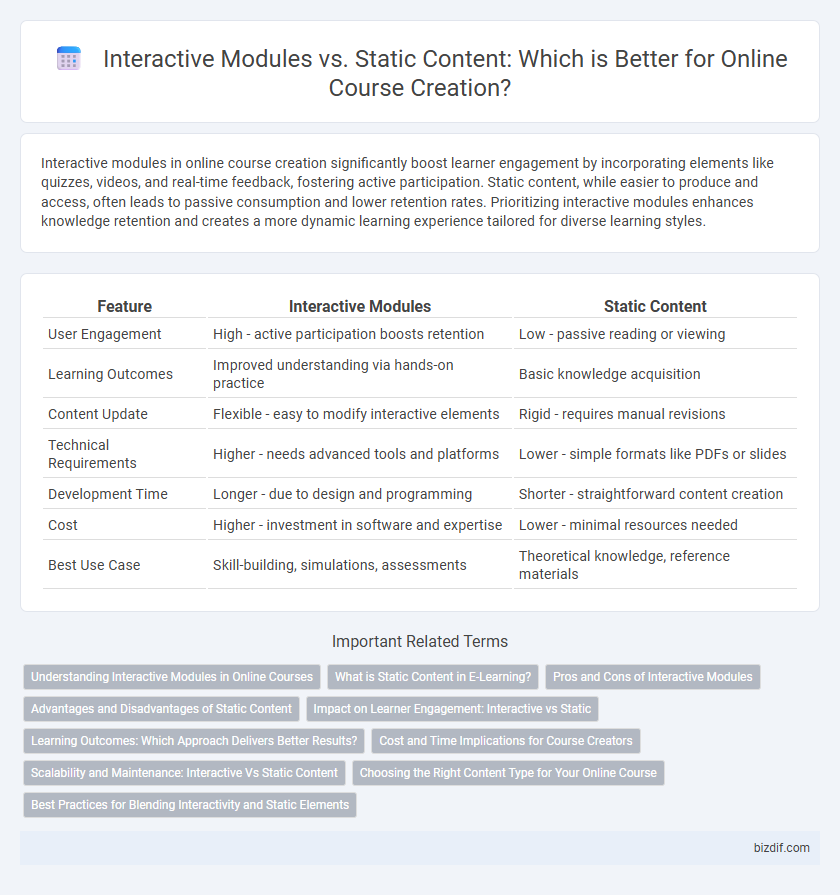Interactive modules in online course creation significantly boost learner engagement by incorporating elements like quizzes, videos, and real-time feedback, fostering active participation. Static content, while easier to produce and access, often leads to passive consumption and lower retention rates. Prioritizing interactive modules enhances knowledge retention and creates a more dynamic learning experience tailored for diverse learning styles.
Table of Comparison
| Feature | Interactive Modules | Static Content |
|---|---|---|
| User Engagement | High - active participation boosts retention | Low - passive reading or viewing |
| Learning Outcomes | Improved understanding via hands-on practice | Basic knowledge acquisition |
| Content Update | Flexible - easy to modify interactive elements | Rigid - requires manual revisions |
| Technical Requirements | Higher - needs advanced tools and platforms | Lower - simple formats like PDFs or slides |
| Development Time | Longer - due to design and programming | Shorter - straightforward content creation |
| Cost | Higher - investment in software and expertise | Lower - minimal resources needed |
| Best Use Case | Skill-building, simulations, assessments | Theoretical knowledge, reference materials |
Understanding Interactive Modules in Online Courses
Interactive modules in online courses enhance learner engagement by incorporating quizzes, simulations, and real-time feedback, which promote active participation and better retention of material. They adapt to individual learning styles through dynamic content, enabling personalized pacing and deeper understanding compared to static content. Utilizing interactive elements increases motivation and supports skill development by providing practical application opportunities within the virtual learning environment.
What is Static Content in E-Learning?
Static content in e-learning refers to fixed instructional materials such as text, images, and pre-recorded videos that do not change or respond to learner input. This type of content presents information in a linear, non-interactive format, making it easier to produce but often less engaging for learners. Common examples include slide decks, PDF documents, and lecture recordings that serve as the backbone of foundational course material.
Pros and Cons of Interactive Modules
Interactive modules enhance online course engagement by promoting active learner participation through quizzes, simulations, and real-time feedback, resulting in improved knowledge retention and skill application. They accommodate diverse learning styles and foster critical thinking, but require more development time, technical resources, and can pose accessibility challenges for some users. Despite these drawbacks, interactive modules significantly elevate course effectiveness compared to static content, which often leads to passive learning and lower interaction rates.
Advantages and Disadvantages of Static Content
Static content provides a consistent and reliable learning experience with low development costs and easy maintenance, making it ideal for straightforward information delivery. However, it lacks engagement and personalization, which can result in lower learner motivation and limited adaptability to different learning styles. The absence of interactivity in static content may decrease retention rates compared to interactive modules that actively involve learners.
Impact on Learner Engagement: Interactive vs Static
Interactive modules significantly enhance learner engagement by fostering active participation, immediate feedback, and personalized learning experiences, unlike static content which often leads to passive consumption and lower retention rates. Features such as quizzes, simulations, and discussion forums in interactive modules promote deeper cognitive processing and higher motivation. Studies show courses with interactive content can increase completion rates by up to 50% compared to static-only formats.
Learning Outcomes: Which Approach Delivers Better Results?
Interactive modules engage learners through dynamic elements such as quizzes, simulations, and multimedia, leading to higher retention rates and improved critical thinking skills compared to static content. Studies indicate that interactive content boosts learner motivation and facilitates deeper understanding by encouraging active participation and immediate feedback. Consequently, courses incorporating interactive modules demonstrate significantly enhanced learning outcomes and skill acquisition versus traditional static materials.
Cost and Time Implications for Course Creators
Interactive modules in online course creation demand higher upfront investment and longer development times due to the need for specialized software, multimedia elements, and user engagement design. Static content, such as text and images, reduces initial costs and accelerates production but often results in lower learner retention and engagement rates. Course creators must balance budget constraints with pedagogical goals to optimize both cost-efficiency and educational impact.
Scalability and Maintenance: Interactive Vs Static Content
Interactive modules enhance scalability by allowing updates to individual components without overhauling entire courses, reducing maintenance time and costs. Static content requires full revision for every update, making it less flexible and more resource-intensive to maintain. Leveraging interactive elements supports continuous improvement and easier adaptation to different learner needs, optimizing course longevity and efficiency.
Choosing the Right Content Type for Your Online Course
Interactive modules enhance learner engagement and retention by incorporating quizzes, simulations, and real-time feedback, making complex concepts easier to grasp. Static content like videos and text provide a consistent, easily accessible foundation but may lack dynamic interaction, which can limit learner motivation. Selecting the right content type depends on course objectives, target audience preferences, and the subject matter's complexity to maximize educational effectiveness.
Best Practices for Blending Interactivity and Static Elements
Blending interactive modules with static content enhances learner engagement and knowledge retention by balancing dynamic participation and clear, concise information delivery. Best practices include integrating quizzes, simulations, and multimedia elements within static text or slides to create a cohesive and varied learning experience. Effective course design ensures interactive components reinforce key concepts without overwhelming the learner, promoting active learning and content mastery.
Interactive Modules vs Static Content Infographic

 bizdif.com
bizdif.com